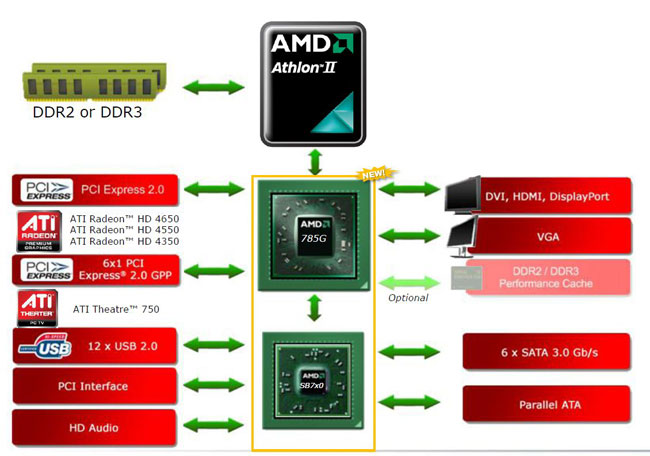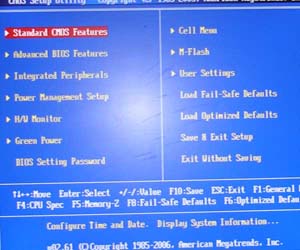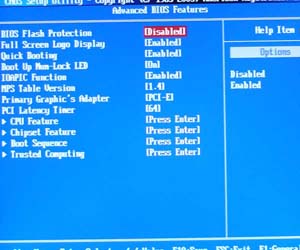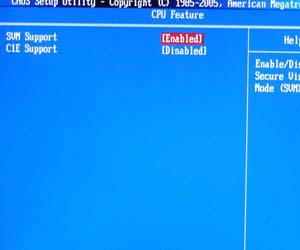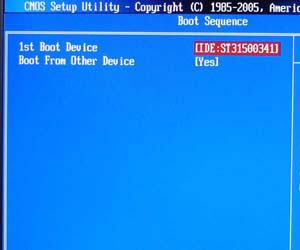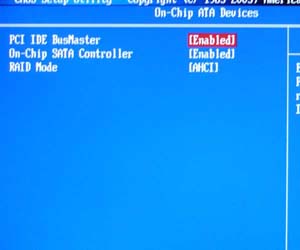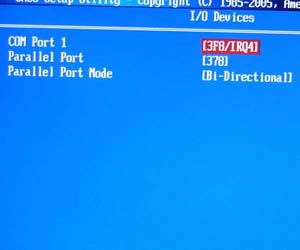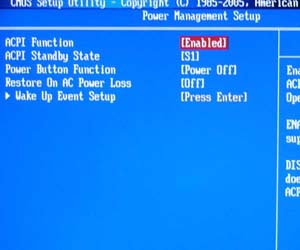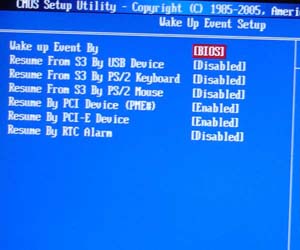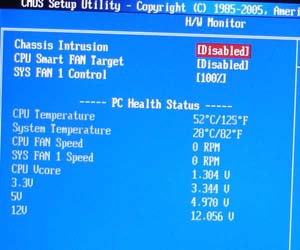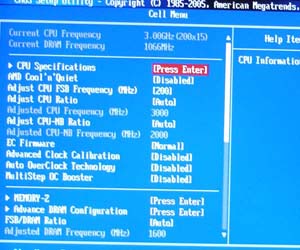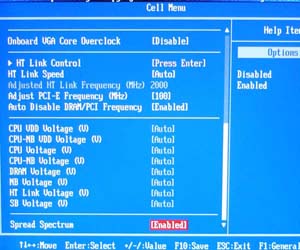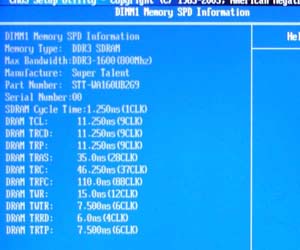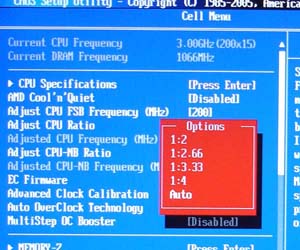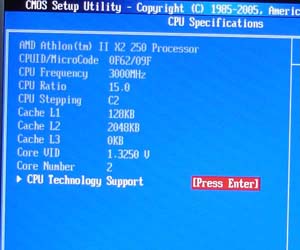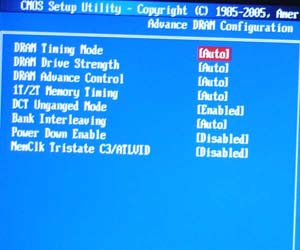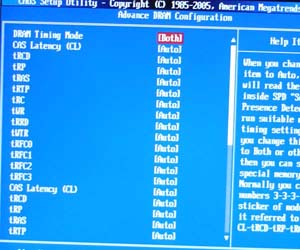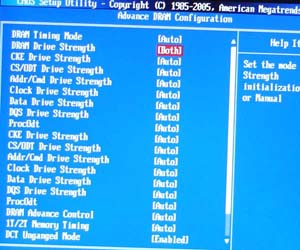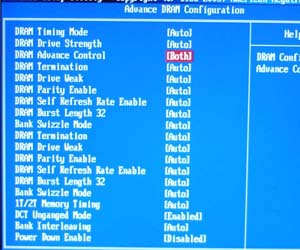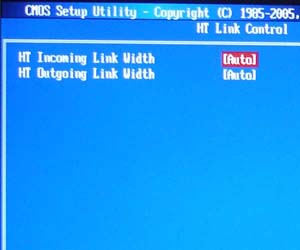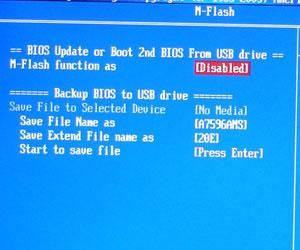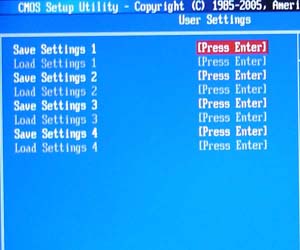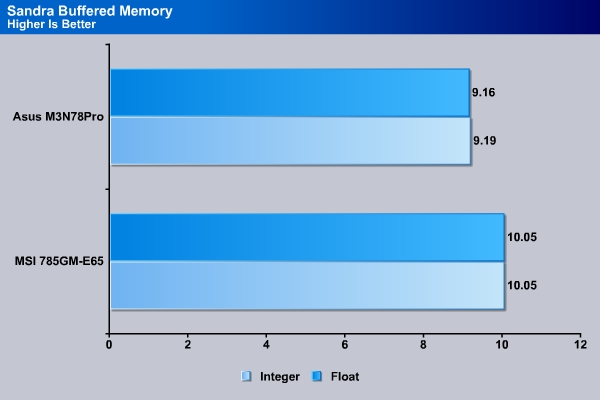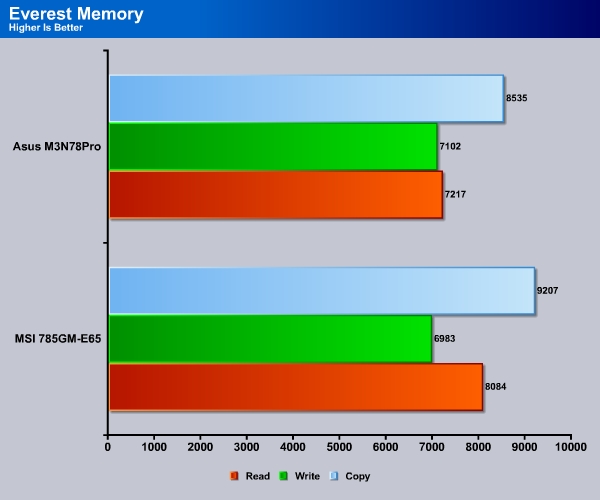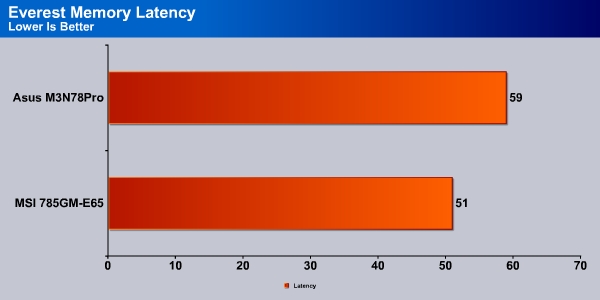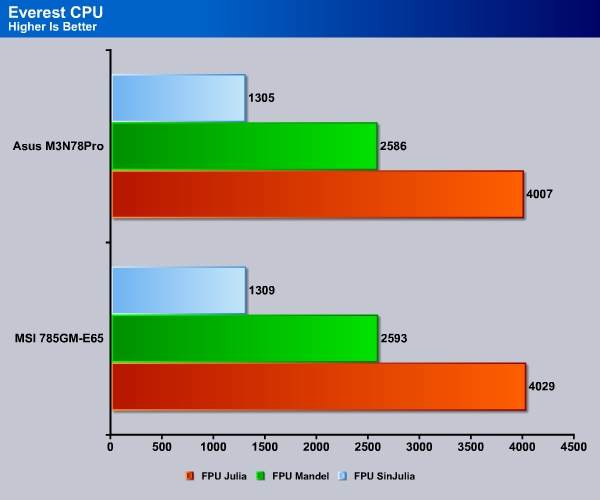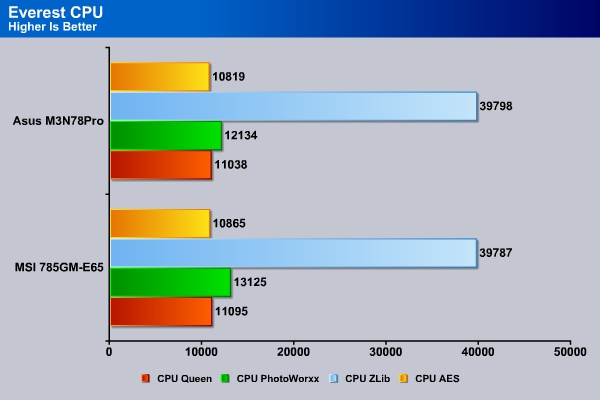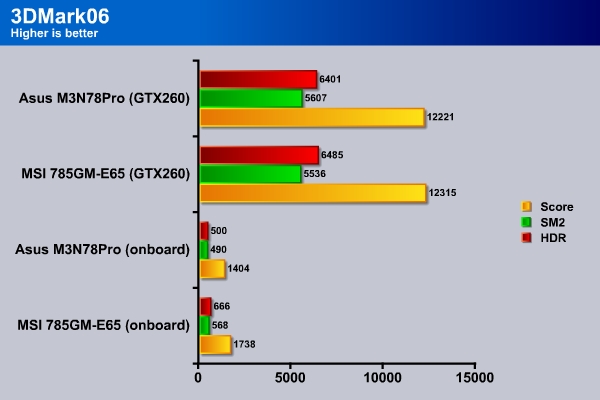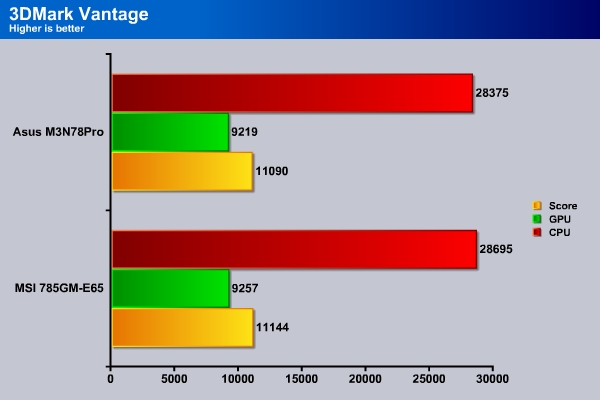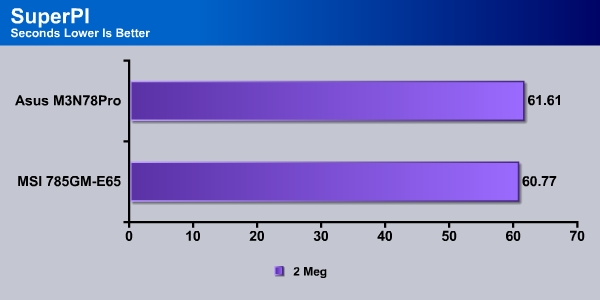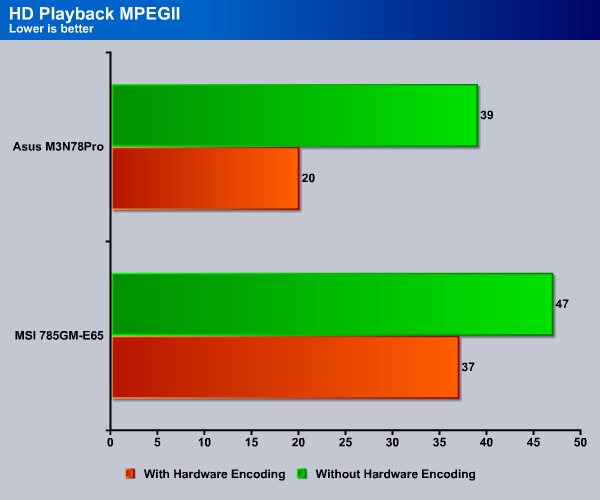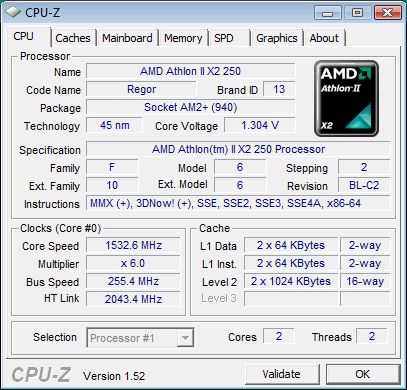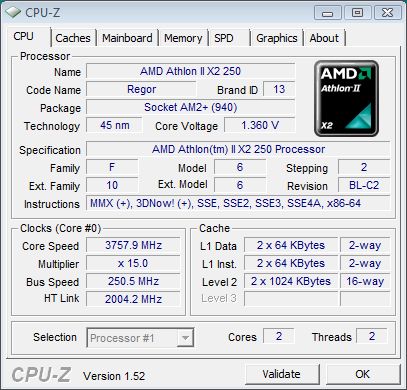The MSI 785GM-E65 is a micro ATX board packed with features built with the updated AMD 785G chipset with 128MB SidePort memory. It may just be the best choice for HTPC board we have tested so far. How does it fares against the competitor? Check our review as we put it against the NVIDIA GeForce 8200.
INTRODUCTION
It is very hard to live without a computer in this digital world we live in. In fact, I bet that many people actually have more than one PCs. It is common to find at least one desktop PC and a laptop in any household and many households even have one dedicated PC as a home entertainment system.
A lot of the home entertainment systems uses integrated graphics because the system is designed to simply output ditial images to the TV and not for gaming. Motherboards with integrated graphics have come a long way. They used to be cheap boards that often got integrated into system builder and OEM manufacturers to cut down the costs. Over the years, motherboards with integrated graphics have matured to a point where if you do not game at all, they are a very good board for day-to-day use. The graphic chip that is bundled with the motherboard often will be sufficient for most people whose primary task is browsing webs, watching movies, and working. They are even good enough to play some games at low resolution. All of the current motherboards with integrated graphics also support DirectX 10, making them a good choice for HTPC for being fully supporting Microsoft Windows Vista and even the upcoming Windows 7.
On August 3rd, 2009, AMD launched 785G and chipset, an updated version of their popular 780G chipset. The 785G is essentially the same 780G with a few upgrades, which makes it an even better chipset for the HTPC user.
The biggest enhancement for the 785G would be its updated graphic controller base on the HD 4200. Most noticeably, improvements over the older 780G chipset would be the UVD 2.0 support for full MPEG-2/VC-1/H.264 hardware acceleration, DVI and HDMI output, and HDCP encoding. The chipset also supports DirectX 10.1 so it would be fully ready for Windows 7. Something unique about the new chipset would be the dual-stream PiP technology on Blu-ray 1.1 playback with multi-monitor capability. The new chipset also made an upgrade to HDMI 1.3 from 1.2.
Although there is a rumor that the chipset will support LPCM audio over HDMI, the information has been confirmed that the chipset in fact does not support it. Neither does it support the TrueHD and DTS-HD audio bit-streaming. A true HTPC user may find it quite disappointing to see these options missing. To give some credit, other competitive chipsets such as NVIDIA GeForce 8300/9300 does not support the TrueHD and DTS-HD Audio over HDMi either but the chipset does support 8 channel LPCM bitstreams audio.
The graphic chip, HD 4200, on the 785G has the same numbers of stream processor (40) as the HD 3200 found on the 780G. The stream processors are running clock speed of 500MHz. However, the new chip features AMD’s PowerPlay technology which will reduce the clockspeed to as low as 60Hz when the GPU utilization is low. This will saves power consumption, which is something that HTPC users would appreciate.
The chipset also supports AMD’s SidePort technology where up to 128MB of flash memory can be used. This will reduce the need for the IGP to share with the system memory. Also, the hybrid CrossFire is supported but only when it is paired with the older HD 3450/3470 video cards.
The chipset communicates via a 2.0 GHz HyperTransport link and will support the latest AM3 socket processors. It is native PCI Express 2.0 with up to 22 PCIE 2.0 lanes and four PCIE 1.1 lanes between the two bridges. The 22 lanes would be split into a single x16 for the graphics card and six x1 lanes for expansion slots.
Along with the new 785G chipset, AMD has also released the SB710 chipset. It is essentially the SB750 without the support for RAID 5 array. It supports six SATA II ports in RAID 0, 1, and 0+1 configuration. A single ATA channel is also supported, twelve USB 2.0, and HD audio. Noticeably missing is the native network port so the chipset would have to rely on third party. The lacking of RAID 5 is probably not going to cause a major drawback for this chipset as the board is most likely be targeted toward HTPC users than power user.
MSI 785GM-E65
Our review sample, courtesy of the MSI, comes in a rather small box as it is a micro ATX board. For a HTPC board, it’s an idea size. The black and blue color adorns the PCB and the slots.
MSI includes a page of certification with a few benchmarks to show off the motherboard’s performance.
Solid state capacitors are used throughout the board. Despite the fact the board is rated to support up to 140W CPU, it only requires a sole 4 pin auxiliary ATX power connector. This means that the latest Phenom 965 BE that we have reviewed will have no problem in the board.
Over the CPU socket area, we can see that MSI uses heatpipe connects the MOSFET and Northbridge. Plenty of spaces around the CPU socket for even the largest heatsink. Four DDR3 memory slots capable of supporting DDR3 800/1066/1333 in dual channel mode. Up to 16GB (4x4GB) DDR3 memory is supported. The closeness of the DIMM slot to the CPU may pose some clearance issue for those with taller memory heat spreader and larger CPU heatsink. Despite the official AM3 processor only support DDR3-1066 speed and the board is rated at that speed, we had no issue running the board at 1600MHz. A small and low height heatsink is placed above the Southbridge.
The usual ATX power connector, IDE and floppy connector are located next to the DIMM slots. MSI decides to place the ATX connector behind the IDE connector which can be somewhat inconvenient when it comes to the installation of the ATX power cable. A legacy printer connector is located just on the upper edge of the board. Next to the main ATX connector is the Trusted Platform Module (TPM module) header.
Way toward the lower left hand if where you will find the five SATA ports. We are glad to see MSI place four of the SATA ports at 90 degrees angle. Although, we are not a big fan of such connector, we like to see it on a micro ATX board because of the space limitation and the fact that long graphics cards often will block SATA ports. By having the ports at an angle, it will avoid any clearance issue that potentially can rise from a longer card.
Three USB headers, one FireWire header, audio header, CD audio header, and the front panel headers are located conveniently on the left edge of the board. A speaker is also found on the board next to the Southbridge to help diagnose any potential issue.
In terms of expansion, MSI supplies the board with a PCIE x1, a PCIE x16, and two PCI slots. It is probably enough for most people. We actually would probably to see an x4 PCIE slot but due to the limitation of the chipset, there is not much that MSI can do about it.
Next to the PCIE x1 slot is MSI’s Easy OC Switch. Basically by adjusting the switch, the board will automatically overclock the CPU and Memory at the pre-set levels. Next to the NB chipset is where the 128MB Elpedia memory is located for the sideport.
Rounding up to the back is where the usual ports are located. There is a little something for everyone. Here you will find the DVI-D, VGA, HDMI, six USB ports, a FireWire, a Gigabit LAN, an eSATA port, an optial SPDIF out, and six channel HD auido port. Realtek RTL8111DL is the network controller linked to the chipset via PCIE interface. Realtek ALC888S/ ALC889 provides the integrated audio. The chip supports true Blu-ray audio support with flexible 8 channel audio with jack sensing.
Not much accessories are bundled with the board. We got a very nice and detailed manual and a very useful overclocking guide detailing the board’s overclocking feature. In additinon, a single SATA data cable and SATA to molex power adapter, IDE cable,backplate IO, and the driver CD. It seems like motherboard manufacturers are cutting down the costs by reducing the accessories bundled with the board. The accessories bundled with the board will get the system up and running without any issue. However, we do hope MSI can include a few additional SATA data cables.
BIOS
MSI’s manual provides very detail explanation for the BIOS settings. It is one of the best manual we have seen that details various options about its BIOS settings. The MSI 785GM-E65 uses American Megatrends, Inc BIOS v02.61.
Standard BIOS menu options are found with a couple of exceptions. Here you will find the Standard CMOS Features where you will find the list of drives. We specially love the fact MSI labels one of its SATA port as E-SATA port to offer information as to which drive is connected to the E-SATA port. Under System Information is where you will also get detail system hardware information.
Advanced BIOS Features offers option to select booting options and various settings for the CPU and Chipset. The BIOS Flash Protection let users to flash the BIOS directly within the BIOS (more on this a bit later). IOAPC allows users to turn on/off the Advanced Programming Interrupt Controller where enable such feature allows available IRQ for the system. MPS Table Version allows users to select which MPS (Multi-Processor Specification) version to be used for the operating system. Primary Graphics Adapter let user to choose PCI-E, PCI or the Onboard graphics. PCI Latency Timer controls how long a PCI device can hold the bus before another takes over.
Under CPU feature is where user can adjust the SVM and C1E support. SVM support let users to turn on or off the secure virtualization mode while the C1E turns on or off the Enhance Halt state. Only enable these features if your processor supports them.
Chipset Features offers control over the integrated graphics. Users can adjust the sideport support and assign the shared memory. The SidePort memory frequency can also be adjusted and the UMA to SidePort ratio can be adjusted as well.
Under Boot Sequence is where users can adjust the primary boot device and the Trusted Computing Module status can be cleared in the BIOS.
Integrate Peripheral Menu let user to adjust all ports on the motherboard. Here users can adjust the USB controller, Lan port, Onboard IEEE 1394 controller, and the HD Audio controller.
Under the On-Chip SATA Devices is where users get to set the hard drives as IDE, RAID, or ACHI.
Power Management Menu let user to adjust the ACPI function and mode. Also, users can adjust the Wake Up functions.
H/W Monitor displays the system health information
Cell Menu
Cell Menu is where users can use to overclock their system. MSI offers a few basic options in the main Cell menu and more advanced options are hidden under the submenus.
The CPU Specifications submenu offers user detail information about the processor installed. It also lists the detailed features such as MMX, SSE extensions, 3D Now, and virtualization. It would make it easier to turn on or off certain option in the BIOS. AMD’s Cool ‘n’ Quiet option can be turned on or off under here.
The FSB Frequency allows overclocking of the processor’s speed up to 600 MHz in incremental of 1MHz can be adjusted.
The CPU Ratio allows users to adjust their multiplier. For processor with locked multiplier, it will have the option to adjust the multiplier in 0.5x stepping all the way up to the maximum multiplier. If it is paired with a processor with unlocked multiplier, it can go higher the default multiplier.
The CPU-NB Ratio controls the CPU to Northbridge Ratio that affects the frequency of the CPU memory controller and the L3 cache. It can be adjusted with settings of Auto, x6~x10.
The Advanced Clock Calibration will allow users to set the CPU Ratio higher than stock when it is enabled. It will help to “unlock” the higher Phenom processor frequency. The feature can only be used with Black Edition of the Phenom processor. There are some motherboards with such feature and special BIOS that allows user to “unlock” hidden cores as well but we could not test with this board because we did not have a triple-core processor to test it.
EC Firmware will work in conjunction with the ACC feature to provide automatic overclock the processor.
Auto OverClock Technology will let the motherboard automatically detect the highest FSB.
MultiStep OC Booster allows users to delay the overclocking settings in the BIOS after the system has booted into the BIOS. There are two Modes available. Mode 1 will boot the system at low frequency through the operating system while Mode 2 will boot the system at medium frequency through the operating system. This is a very useful tool for those who wish to attain the highest overclocking potential within Windows without the need to reset the CMOS after a failed overclocking setting that crash the BIOS.
We love that MSI puts the Memory-Z option in the BIOS where it will show the memory’s SPD information. Again, it is that little something that would come very handy for those who wish to adjust the settings without the need to fumble for the manual or spec sheet.
Advanced DRAM Configuration is where all of the settings for the memory can be found. Here users can adjust the DRAM Timing and DRAM Drive Strength. Plenty of options are available for the enthusiast. Under the DRAM Advance Control is where users can further fine-tune the memory settings with the settings such as DRAM Termination, Drive weak, and parity mode. The memory settings can be adjusted per channel basis.
In addition, the Command Rate can be adjusted with settings of 1T or 2T. The DCT Unganged Mode is used to integrated two 64-bit DCT into a 128-bit interface, Bank Interleaving allows the system to access multiple banks simultaneously, Power Down is the memory power saving technology, and the MemCLK Tristate C3/ATLVID is another power saving.
I am not a big fan of the way the Memory menu is organized. It is a bit too messy to have all of these settings in one continuous page. You would have to scroll through various settings if you only want to adjust a few settings within each submenu. A better organization would be appreciated especially considering that the board is targeted toward HTPC or mainstream/budget user. First time overclocker who sees all of these advanced options can be a daunting task to know what settings to adjust.
The board offers FSB/DRAM Ratio is settings of 1:2, 1:2.66, 1:3.33, and 1:4. The default FSB for the Phenom II processor is 200MHz, so this ratio yields a maximum memory speed of 1600MHz.
The board also allows overclocking the onboard graphics card. The Onboard VGA Core Overclock allows users to adjust the integrated graphics frequency up to 999MHz. The HT Link Control adjusts the incoming and outgoing link width with 8 bit or 16 bit options. The HT Link Speed can be adjusted from x1 to x10 in increments of x1. PCI-E frequency controls the PCI-E frequency up to 150MHz maximum setting and the DRAM/PCI Frequency will turn off clocks from empty DRAM/PCI slot to minimize the EMI.
MSI 785GM-65 let user controls the CPU VDD voltage up to 1.325 V, CPU-NB VDD up to 1.325 V, CPU up to 2.010 V, CPU-NB up to 1.533 V, DRAM up to 2.42 V, NB up to 1.337V, , HT Link up to 1.454V, and the SB up to 1.472. The Northbridge and the HyperTransport voltage are being adjusted together while every other setting can be adjusted individually.
MSI offers a very handy tool call M-Flash where user can use it to backup and flash the BIOS with USB drive. This option also allows user from BIOS file inside an USB stick in the event of a failed BIOS to recover the BIOS. User Settings allows users to save up to four profiles.
TESTING & METHODOLOGY
To test the MSI 785G-E65 we did a fresh load of Vista 64 bit and updated the Operating System and drivers with all the latest versions and patches. Then we loaded the testing software and ran the machine for a few days to confirm everything was installed correctly and gave the machine a little burn in time.
Once again, we’d like to remind you that we have used the same hardware connected to the motherboard that we’ve been using on all our motherboards in this series of reviews. We use the same HD, same CPU Cooler, and keep the hardware except the Motherboard, RAM, and CPU the same as much as possible. It makes for better benchmarking if you keep the hardware as close to the same across the spectrum of tests.
| Test Rig | |
| Case Type | None |
| CPU | AMD Athlon X2 250 |
| Motherboard |
MSI 785G-E65 Asus M3N78 Pro |
| RAM |
Super Talent WA160UX6G9 |
| CPU Cooler |
Thermalright SI-128 with IXTREMA PRO SEREIES IXP-74-14 |
| Hard Drives |
Seagate Barracuda 7200.11 1.5TB (Main) Western Digital WD500ABPS (testing drive) |
| Optical | Nec DVD-RW ND-3520AW |
| GPU Tested | Asus ENGTX260 Matrix |
| Testing PSU | Cooler Master UCP 900W |
| Legacy | Floppy |
| Mouse | Logitech G7 |
| Keyboard | Logitech Media Keyboard Elite |
Test Suite
|
Synthetic Benchmarks |
|
3DMark Vantage v. 1.01 |
|
3DMark06 v. 1.1.0 |
|
SiSoft SANDRA XII Professional SP2 |
|
Everest Ultimate Edition v. 4.50.1330 |
|
Cinebench R10 64 bit |
|
WinRar v. 3.71 |
Sisoft Sandra 2009 SP1
“SiSoftware Sandra (the System ANalyser, Diagnostic and Reporting Assistant) is an information & diagnostic utility. It should provide most of the information (including undocumented) you need to know about your hardware, software and other devices whether hardware or software. It works along the lines of other Windows utilities, however it tries to go beyond them and show you more of what’s really going on. Giving the user the ability to draw comparisons at both a high and low-level. You can get information about the CPU, chipset, video adapter, ports, printers, sound card, memory, network, Windows internals, AGP, PCI, PCI-X, PCIe (PCI Express), database, USB, USB2, 1394/Firewire, etc.”
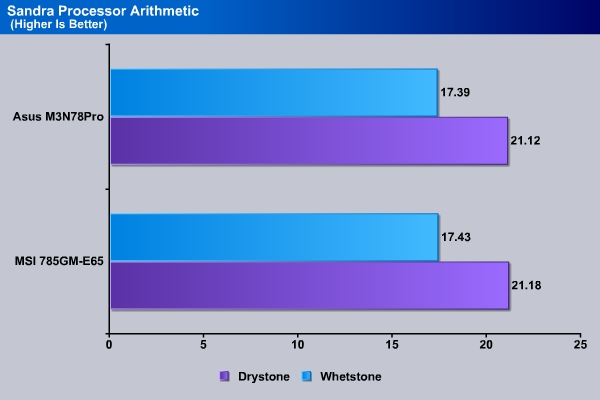
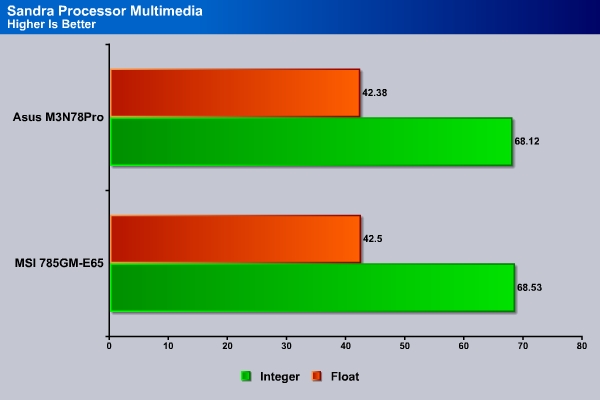
The Sandra memory test favors the 785G as expected due to the 1333MHz DDR3 memory that was used.
EVEREST ULTIMATE
“EVEREST Ultimate Edition is an industry leading system diagnostics and benchmarking solution for enthusiasts PC users, based on the award-winning EVEREST Technology. During system optimizations and tweaking it provides essential system and overclock information, advanced hardware monitoring and diagnostics capabilities to check the effects of the applied settings. CPU, FPU and memory benchmarks are available to measure the actual system performance and compare it to previous states or other systems. Furthermore, complete software, operating system and security information makes EVEREST Ultimate Edition a comprehensive system diagnostics tool that offers a total of 100 pages of information about your PC.”
The Everest memory test has the 785G taking a commanding lead in the memory read and copy test. However, we see the M3N78Pro actually yields a slightly lead in the memory write test.
No surprise here as the faster DDR3 yields a better latency despite tighter timing on our DDR2 board.
In our first set of Everest CPU benchmark, we see the 785G edges out the M3N78Pro just as we have observed in the Sandra.
Things get a bit interesting with the second set of Everest CPU test. Here we can see the 785G wins two out of four tests (CPU Queen and CPU AES) but comes in second in the other two tests (CPU PhotoWorxx and CPU ZLib). Both the PhotoWorxx and ZLib stresse the integer arithmetic and multiplication execution units of the CPU and the memory subsystem. So it is likely that the better memory write performance we have seen with the M3N78Pro has the effect in the overall performance lead.
3DMARK06 V. 1.1.0
3DMark06 developed by Futuremark, is a synthetic benchmark used for universal testing of all graphics solutions. 3DMark06 features HDR rendering, complex HDR post processing, dynamic soft shadows for all objects, water shader with HDR refraction, HDR reflection, depth fog and Gerstner wave functions, realistic sky model with cloud blending, and approximately 5.4 million triangles and 8.8 million vertices; to name just a few. The measurement unit “3DMark” is intended to give a normalized mean for comparing different GPU/VPUs. It has been accepted as both a standard and a mandatory benchmark throughout the gaming world for measuring performance.
This is probably the test where most people would be interested. Let’s start with the onboard graphics. The 785G is undoubtly a better choice for the integrated video. The HD4200 on the 785G yields 20% higher in the overall score compare to the GeForce 8200 found on the M3N78Pro. We are not sure if the performance is purely due to the better graphics card on the 785G or also related to the included 128MB SidePort memory. Our subsequent review will compare the performance of the 785G with and without the SidePort.
When we pair both board with GTX 260, we can see that once again the 785G is able to edges out the M3N78Pro. Close examine the test shows that the 785G actually has a better result in the HDR but M3N78Pro has a better result in the SMD2 test.
3DMark Vantage
For complete information on 3DMark Vantage Please follow this Link:
www.futuremark.com/benchmarks/3dmarkvantage/features/
The newest video benchmark from the gang at Futuremark. This utility is still a synthetic benchmark, but one that more closely reflects real world gaming performance. While it is not a perfect replacement for actual game benchmarks, it has its uses. We tested our cards at the ‘Performance’ setting.
Currently, there is a lot of controversy surrounding NVIDIA’s use of a PhysX driver for its 9800 GTX and GTX 200 series cards, thereby putting the ATI brand at a disadvantage. Whereby installing the PyhsX driver, 3DMark Vantage uses the GPU to perform PhysX calculations during a CPU test, and this is where things get a bit gray. If you look at the Driver Approval Policy for 3DMark Vantage it states; “Based on the specification and design of the CPU tests, GPU make, type or driver version may not have a significant effect on the results of either of the CPU tests as indicated in Section 7.3 of the 3DMark Vantage specification and white paper.” Did NVIDIA cheat by having the GPU handle the PhysX calculations or are they perfectly within their right since they own Ageia and all their IP? I think this point will quickly become moot once Futuremark releases an update to the test.
We could not get the 3DMark Vantage to run with the 785G board so we cannot provide a comparison result for 3DMark Vantage with the integrated graphics. We believe that this is due to a driver issue with the new motherboard chipset. Hopefully it will get fixed soon with new driver release.
With the GTX 260, again the 785G is clearly the winner with more up to date benchmark.
Cinebench
“CINEBENCH is a real-world test suite that assesses your computer’s performance capabilities. MAXON CINEBENCH is based on MAXON’s award-winning animation software, CINEMA 4D, which is used extensively by studios and production houses worldwide for 3D content creation. MAXON software has been used in blockbuster movies such as Spider-Man, Star Wars, The Chronicles of Narnia and many more. MAXON CINEBENCH runs several tests on your computer to measure the performance of the main processor and the graphics card under real world circumstances. The benchmark application makes use of up to 16 CPUs or CPU cores and is available for Windows (32-bit and 64-Bit) and Macintosh (PPC and Intel-based). The resulting values among different operating systems are 100% comparable and therefore very useful with regard to purchasing decision-making. It can also be used as a marketing tool for hardware vendors or simply to compare hardware among colleagues or friends.”

Again, CineBench puts the 785G ahead of the M3N78Pro.However, we see that in the OpenGL test, the 785G actually lags quite significantly behind the M3N78. We believe the result could be related to the SidePort memory on the board as our other tests (coming soon) with board without SidePort actually yields a very similar result as the M3N78Pro.
WinRar v. 3.80
This module in WinRar generates random data, which contains specially introduced redundancy, increasing the load to both the processor and memory. Data is then passed through RAR compression and decompression algorithms, and the output of the decompression algorithm is compared to the source data. If any differences are found, WinRar then reports “Errors found – Yes” in the command window. WinRar displays a size of processed data and compression speed, current and resulting, in kilobytes per second.
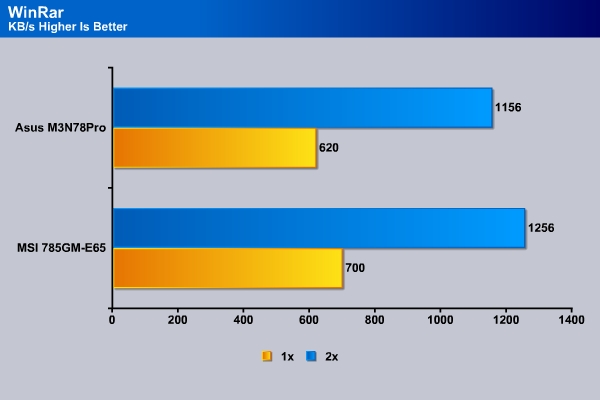
No surprise here that we see the MSI board comes a tad ahead of the Asus board with the faster DDR3 memory.
SuperPi
Super Pi is a program that calculates pi to a specified number of digits after the decimal point up to a maximum of 32 million. The Gauss-Legendre algorithm which is a windows version of a program used by Yasumasa Kanada in 1995 to compute Pi to 232 digits.
Super Pi is used by many overclockers to test performance and stability of their systems. In this community, Super Pi has become the standard for providing benchmarks to compare pi calculation times and demonstrate their overclocking skills. The program can be used to also test the stability of a particular overclocking speed. If a computer can calculate PI to the 32 millionth place after the decimal without a mistake, it is considered moderately stable in terms of RAM and CPU performance. More intensive CPU and RAM tests include calculations that run for hours instead of minutes and better test system stress levels.
SuperPi is a single threaded application that is a very useful tool to gauge the processor’s raw performance. As SuperPi is somewhat sensitive to the memory performance, we do expect to see the 785G comes ahead.
HD TACH
HD TACH performs sequential read and write tests on removable media and fixed disks. HD Tach is also capable of performing the sequential read and write tests on the entire disk instead of the small number of zones in the quick and long test. We opted to use the Short 8 (MB) and Long 32(MB) tests in the sequential read mode only, as sequential writes are covered by other benchmarks.
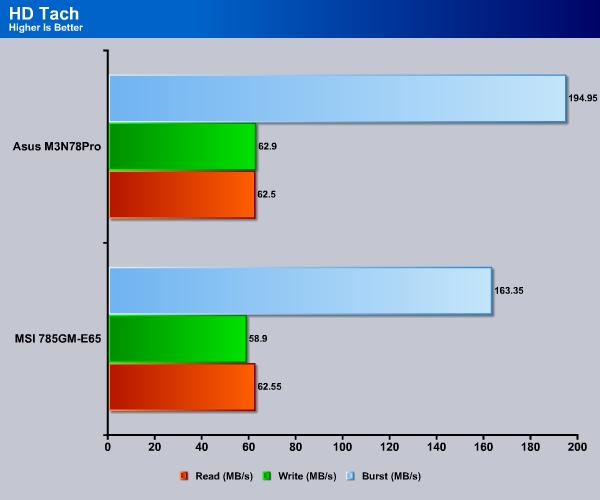
The 710 Southbridge from AMD still has issue with its SATA burst rate performance. This has been an issue with AMD chipset and it probably won’t get fixed until we see the 8 series based Southbridge. Luckily the average read is comparable between both chipsets. However, the 785G lags behind the competitor in the Write area.
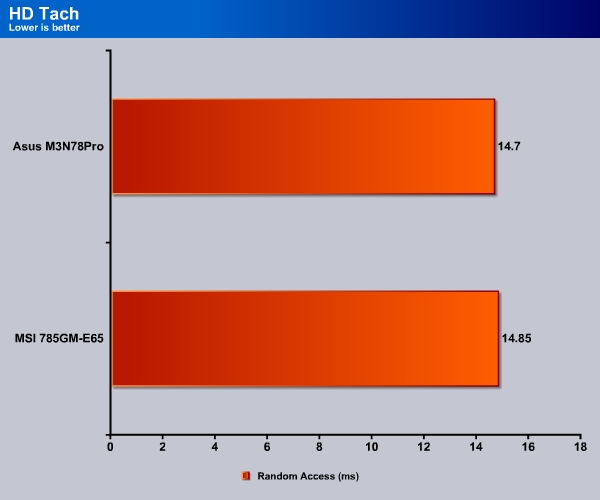
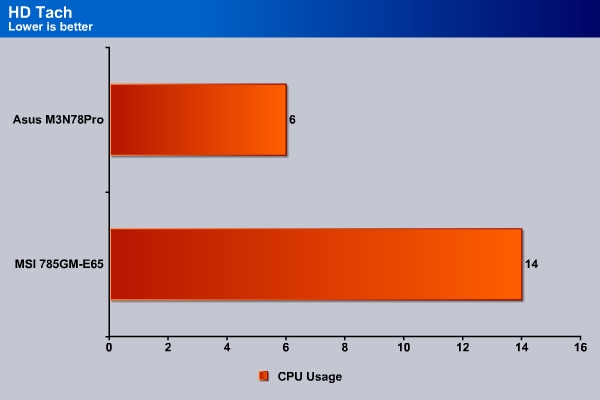
POWER CONSUMPTION
We thought it would be interesting to measure the power consumption of both boards. The power consumption is measured with Kill-A-Watt P4400. All power saving features are disabled. The idle power consumption is measured with the system turned on for 15 minutes with no activity running. The load power consumption is measured with the system running in 3DMark Vantage. The peak power consumption is reported.
The 785G consumes 6W less under idle and 5W less under load compare to the M3N78Pro. Bare in mind that the 785G is a micro ATX board and also uses DDR3 which both can help to reduce its overall power consumption compare to the ATX board with DDR2 on the Asus board.
Six Watts may not seem a lot but it is actually about 10% lower in the power consumption under idle and 5% lower under load. We have not even consider the amount of power that we may have saved once we enabled the other power saving features on the motheboard and the CPU (Cool and Quiet). It is nice to see the 785G is able to offer better graphic performance and yet consumes less power.
HD Playback
We use PowerDVD 9 to playback a couple of video clips encoded in MPEG-2 and MPEG-4. The MPEG2 clip is encoded at 60 Mbps. We recorded the highest CPU usage with Windows Task Manager.
Both GeForce 8200 and 785G are capable of reduce the CPU usage when the hardware encoding is enabled. We were a bit surprised to find that the 785G actually has higher CPU usage with and without the hardware encoding. We believe this is due to the immature drive with the new chipset.
The H.264/MPEG-4 AVC clip is encoded at 8 kbps. Without the GPU to offload the decoding task, the system consumes maximum of 74% of CPU cycle. Once we enabled the hardware encoding, we see the CPU usage dropped to measily 20%. Contrast this to the M3N78Pro, we can see that it is able to consume less CPU cycle.
OVERCLOCKING
To find the maximum FSB, we started by lowering the CPU multiplier to x5 and memory to 800 and set to find the highest bus speed we can achieve. We were able to crank the FSB to 260MHz without increasing any voltage but the system was not able to boot into Windows at default CPU-NB ratio. In order to boot into Windows, we had to lower the speed to 255MHz and lower the CPU-NB ratio to 8x.
Since the Athlon X2 has the multiplier locked, overclocking it requires raising the HyperTransport clock (HT clock). Luckily, due to the fact that the processor lacks L3 cache, it is slightly easier to overclock as CPU-NB ratio is not as critical as other AMD processor with L3 cache. We were able to overclock the processor to 3.7GHz with 250×15 at 1.4v easily. Higher speed is certainly possible at higher voltage but we do not want to risk of damaging our components.
CONCLUSION
AMD’s 785G is an interesting chipset that AMD brings to the market at this time where the industry is anxiously awaits the 8 series chipset that is rumors to be out sometimes next year. It is certainly not a revolutionary chip but rather an evolution from its 780G. This is actually not a bad idea upgraded HD4200 graphics with new UVD, support for socket AM3 processor, and HDMI 1.3. However, we are disappointed to find that it still lack support for multi-channel LPCM output over HDMI and TrueHD and DTS-HD audio bit-streaming. What is worse is that AMD has yet to fix its poor SATA transfer rate and broken ACHI drivers.
The 785G is certainly not going to be a performance killer and its integrated graphics is certainly not going to satisfy a casual gamers. However, it is definitely going to be a very capable chip for a budget build or for an HTPC system with its array of ports and multimedia enhancement. Its biggest competitor, GeForce 8200a/8300a/9300a from NVIDIA, may have a few more features than the 785G but as our tests shown the performance difference between the two chipsets are almost identical for its target audience. However, the 785G does consumes less power and is natively supporting DDR3 memory which none of the current NVIDIA chipset for AM3 processor supports. Not to mention that it also costs less for the 785G.
In terms of video playback, we do see that the 785G is more capable at decoding the H.264/MPEG-4 AVC but it lags behind the GeForce 8200 in the MPEG-2. We do suspect that the driver is not mature enough yet so be sure to keep your driver up to date.
The MSI 785G-E65 that we have reviewed today features a nice array of ports, a decent overclock, and nice overall layout. At retail price of $89.99, this micro ATX board has enough expansion slots (1 PCIE x1, 1 PCIE x16, and two PCI) and six SATA ports should satisfy its target audience. One minor issue we have with the board is probably its display driver where we experienced a slightly higher than usual CPU utilization with our MPEG-2 playback, which can easily be fixed with new driver update.
We are using an addition to our scoring system to provide additional feedback beyond a flat score. Please note that the final score isn’t an aggregate average of the new rating system.
- Performance 8
- Value 9
- Quality 9
- Warranty 9
- Features 9
- Innovation 7
Pros:
+ Decent overclocking
+ Silent heatpipes
+ Support up to 16GB of memory
+ 6 SATA ports (5 SATA and 1 eSATA)
+ Good layout
+ Very nice array of ports
+ Price
+ Onboard Debug Codes
Cons:
– BIOS options can be somewhat complicated for a first builder
– Display driver is still not yet mature enough
– Only includes 1 SATA data cab
The MSI 785G-E65 will receive a score of 8.5 out of 10 and Bjorn3D’s coveted Best Bang for Buck Award for being one of the best motherboard with integrated graphics available.
 Bjorn3D.com Bjorn3d.com – Satisfying Your Daily Tech Cravings Since 1996
Bjorn3D.com Bjorn3d.com – Satisfying Your Daily Tech Cravings Since 1996
